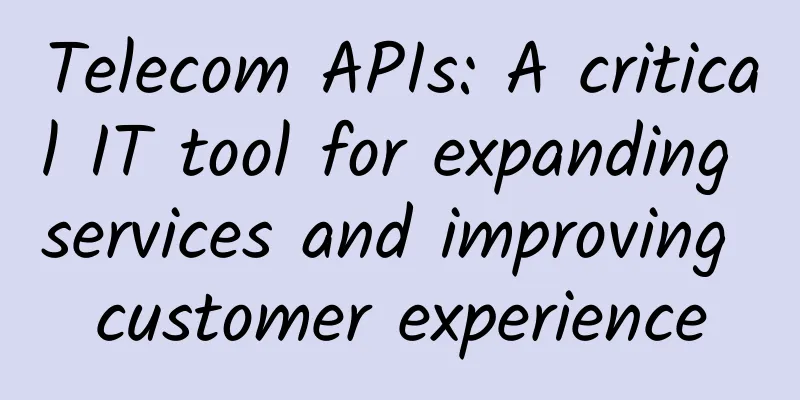Telecom APIs: A critical IT tool for expanding services and improving customer experience

|
In recent years, enterprise communications have undergone a major transformation. Enterprises are looking to new technologies, such as cloud-based tools, to stay ahead of the curve and improve their IT operations. One key cloud-based tool is the telecom application programming interface (API). Telecom APIs allow businesses to add communication capabilities to existing processes, which can streamline workflows and enhance customer experience and engagement. APIs are a useful tool for programmers to develop software or facilitate interaction between two systems. APIs can be used in a variety of ways and are a powerful way to provide scalability and adaptability to businesses. Software developers can use the Telecom API to integrate SMS, calling and other telephony features directly into applications or services in mobile and desktop environments. Developer integration of the Telecom API provides enterprises with direct access and authorization to high-quality telephony resources. These resources help enterprises purchase, port, configure and provision voice and messaging services in real time. Behind the scenes, telecom APIs are generally supported by VoIP networks, routing calls and messages from one user to another. Partnering with a software-centric operator can help IT teams integrate powerful, cloud-based telecom products into existing products and services. Here are three key examples of how business software development teams can integrate telecom APIs to increase their competitive advantage. Connecting mobile and remote workersThe workforce that is working remotely and doing gig work has increased, and it doesn’t seem to be slowing down anytime soon. The Bring Your Own Device (BYOD) trend has played a central role in facilitating employee mobility and has heightened the urgency for businesses to meet their employees’ demands for flexibility and autonomy in their work schedules. To meet the changing needs of their workforce, businesses need a mobile communications strategy that supports a distributed workforce and maximizes employee efficiency. By bringing telecom APIs into their hybrid employee communications strategy, businesses can harness the power of modern telecom solutions and enhance connectivity, regardless of where their employees and customers are. For example, telecom APIs can support businesses in hiring, managing, and interacting with temporary workers, which is particularly useful in industries such as hospitality, retail, and food services. Through an API-enabled website or mobile app, companies can give employees access to a user-friendly platform to manage their work schedules. Using the platform, employers can share updates on company activities and help coordinate unexpected sick days. Employees can easily communicate with team members about shift swaps or text clients about status updates on deliveries or services. Decentralized and highly mobile industries like construction can also benefit greatly from telecom APIs. For example, field service workers can use mobile devices to provide timely project information or disseminate real-time updates to customers. In addition to improving the work environment, APIs can also improve the customer's user interface, which has a positive impact on customer satisfaction. Improve customer serviceToday’s consumers want the flexibility to choose communications services that fit their unique preferences and needs. Data shows that people generally prefer texting over other forms of communication. Specifically, more than 8 in 10 smartphone users would rather be contacted via text than via email. This trend shows that customer communication preferences have evolved in favor of faster, more efficient channels. Giving customers more than one option to interact with a company can strengthen relationships and have a positive impact on brand loyalty. Companies have been incorporating SMS and MMS capabilities into their suite of communication tools in response to the consumer trend toward texting. Messaging APIs power these interactions and can also make SMS/MMS messaging more impactful. SMS APIs can also be used to send text messages to customers once they have opted in to receive them (a core way companies share discount codes, service updates, or sales information with customers). Companies can achieve the immediacy that customers want by leveraging telecom APIs. In addition to providing the communication tools that customers want, telecom APIs can also help companies enhance customer service by leveraging contextual data from past interactions. For example, when a customer calls a company through a telecom API, it will automatically generate a call detail record (CDR). The CDR is then linked to the incoming call number, creating a communication record. From that point on, every time that specific customer contacts the company using that number, a support representative can review the record for important background details. With a chain of past interactions, a company's support team can eliminate the need to ask repetitive questions and provide customers with personalized service. As a result, customers have a heightened experience and are more satisfied with their service. Expanding communication capabilitiesBusinesses of all types can adopt telecom APIs as an automation strategy to expand their services. By taking this approach, businesses can have confidence in their ability to respond to changes that may arise. One use case for leveraging APIs to scale quickly is if a business needs to switch to a new telecom carrier, or add additional phone numbers to its account. Telecom APIs can make the transition process more streamlined by quickly building a bridge to a service or solution. For example, the Number Porting API makes it easy for businesses to add or subtract numbers based on usage. Changes in usage can be affected by business growth, opening a new office, or downsizing a department. Finally, businesses can also use telecom APIs for numbers associated with restaurant reservations, appointment reminders, shipping notifications, hotel reservations, and other services where users want to receive time-sensitive updates via text message or phone call. As businesses navigate change, they can still provide the support and services their customers are accustomed to without breaking their IT budgets.By integrating telecom APIs, businesses can instantly purchase, port, and provision voice and messaging services, with direct access and control of high-quality telephony resources. Enterprises are actively using telecom APIs to support their distributed workforce, improve customer service and retention, and enable greater scalability of communications capabilities. As customer preferences and the technology landscape continue to evolve, enterprises can stay flexible with telecom APIs. |
<<: From MPLS to the Internet: Enterprise Network Optimization in the New Era of WAN
>>: Snapchat QUIC Practice: Small Protocol Solve Big Problems
Recommend
GSA: 5G has become a mainstream technology, and 5G FWA CPE shipments will account for 42% this year
According to a recent study conducted by the Glob...
The number of 5G package users has exceeded 200 million. How to tap the value of 5G?
Recently, the three major domestic operators have...
Operators' first-half report card released: 5G user scale reaches nearly 500 million, competing for 5G applications in the second half
Recently, the operating data of the three major o...
Ministry of Industry and Information Technology: More than 1,800 "5G + Industrial Internet" projects are being built nationwide
Reporters learned from the press conference of th...
Tencent Cloud Double 11 Early Purchase: 2C4G8M cloud server only 70 yuan/year, renewal can get coupons
Tencent Cloud has launched the Double 11 warm-up ...
Accelerating 5G standardization requires coping with the complexity of test scenarios
The fifth generation of mobile communication tech...
Liu Yulin from the Ministry of Industry and Information Technology: Gigabit optical network is the supporting base of new infrastructure
On March 29, at the "Gigabit Optical Network...
Promote 5G integration and innovation and accelerate the digital transformation of the industry
On September 28, the "5G Gigabit Network Ind...
5G spectrum issues remain prominent: experts suggest strengthening collaborative research on high and low spectrum
December 28th morning news (Yue Ming) At the &quo...
Huawei: 5.5G is the only way for 5G network to upgrade and evolve
On March 2, MWC 2023 was held in Barcelona, Spa...
Live broadcast and fan interaction is popular! Yunfan Accelerator will show you the live broadcast and microphone technology behind it
Preface: With the continuous upgrading of bandwid...
Twelve questions about Internet knowledge, do you know?
[[379905]] Preface Countdown to Chinese New Year~...
Western European countries top global broadband speed rankings
[[423948]] Western Europe dominates the global in...
Home broadband can also be wirelessly accessed. What are the benefits for IoT?
People are looking forward to a lower-priced broa...









